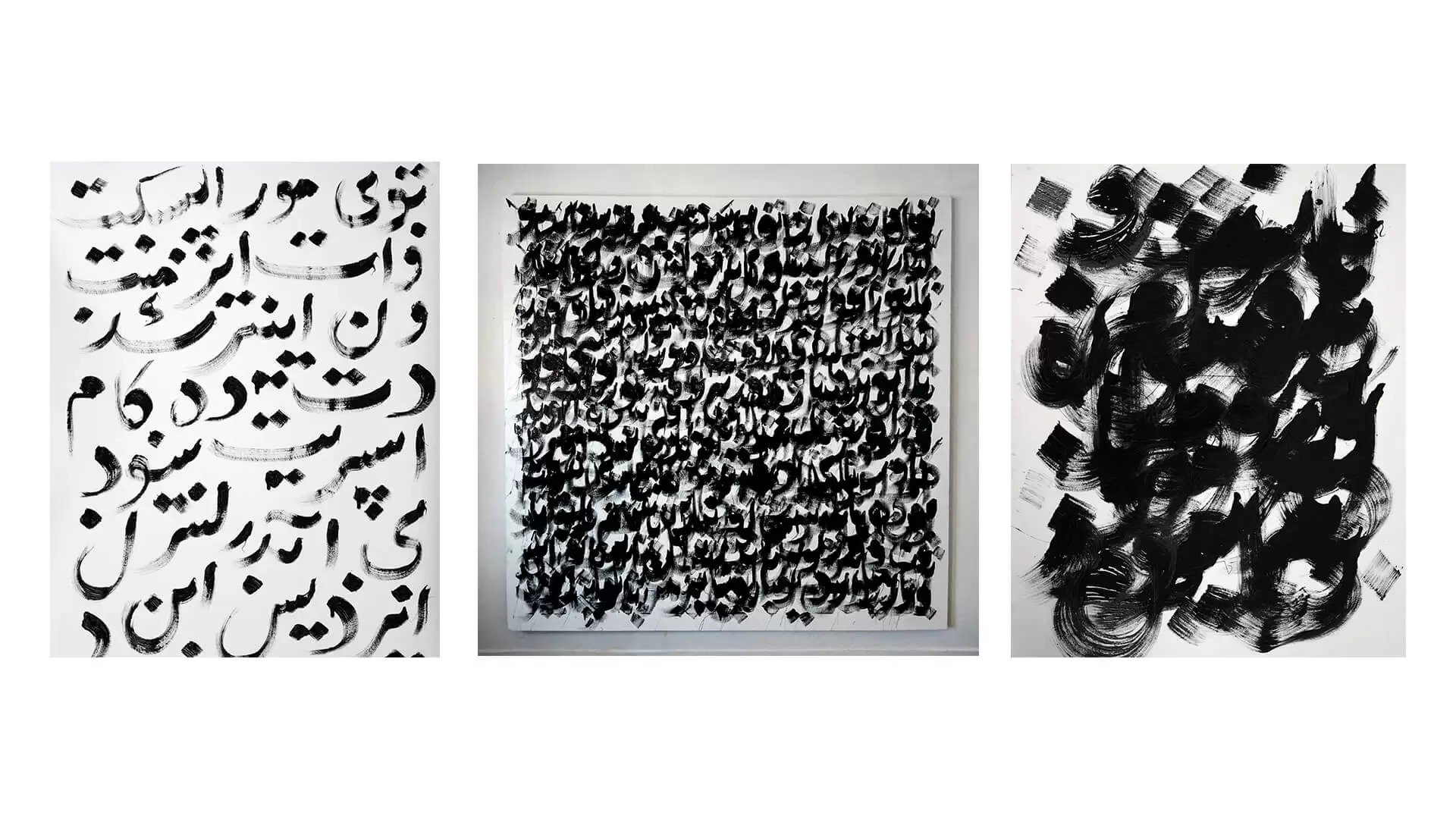Kamyar Bineshtarigh’s minimal brush strokes comment on the functionality of language, the nuances of translation, and perceptions of otherness; his videography evidences the artist’s quiet documentarian observations of movement, with an understanding of gesture that manifests in all of his projects.
The Iranian, Cape Town-based artist doesn’t consider himself a calligrapher per se; his craft functions as a kind of criticism onto itself and on what our standards, knowledge, and preconceptions of what actual Persian Nasta’liq ought to look like. Each of his calligraphic figurations evoke a displaced person or cultural identity, shrouded in a flurry of sociolinguistic subtext.
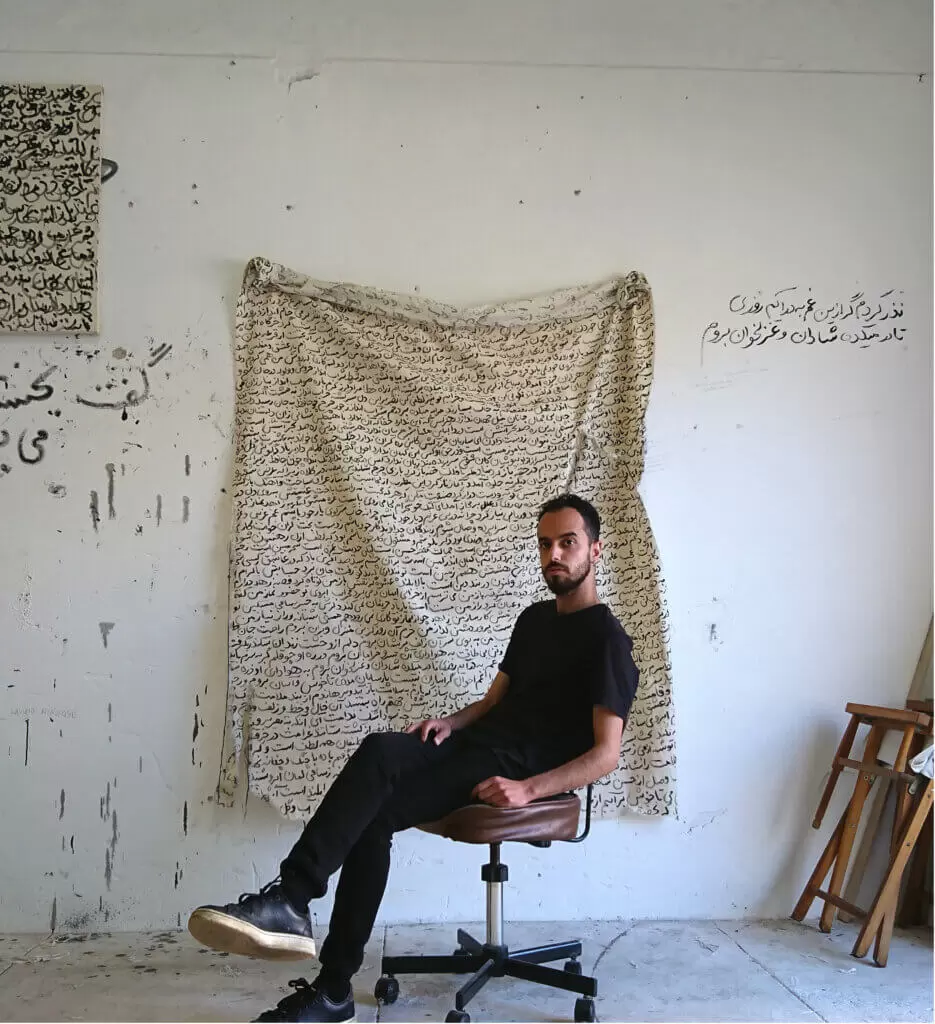
A globalized world necessitates these conversations on translation and identity—what art theorist and curator Nicolas Bourriaud calls “translation-oriented modernity”—and Bineshtarigh is in line with such depictions of fragmented, global cultural consciousness. In his work, translation is a practice rooted in displacement and distortion, and while we may think his language-based pieces are a statement on the manipulation of a text translated to English, it is equally critical of the reverse act, when an English text is reconfigured into a language like Arabic or Farsi.
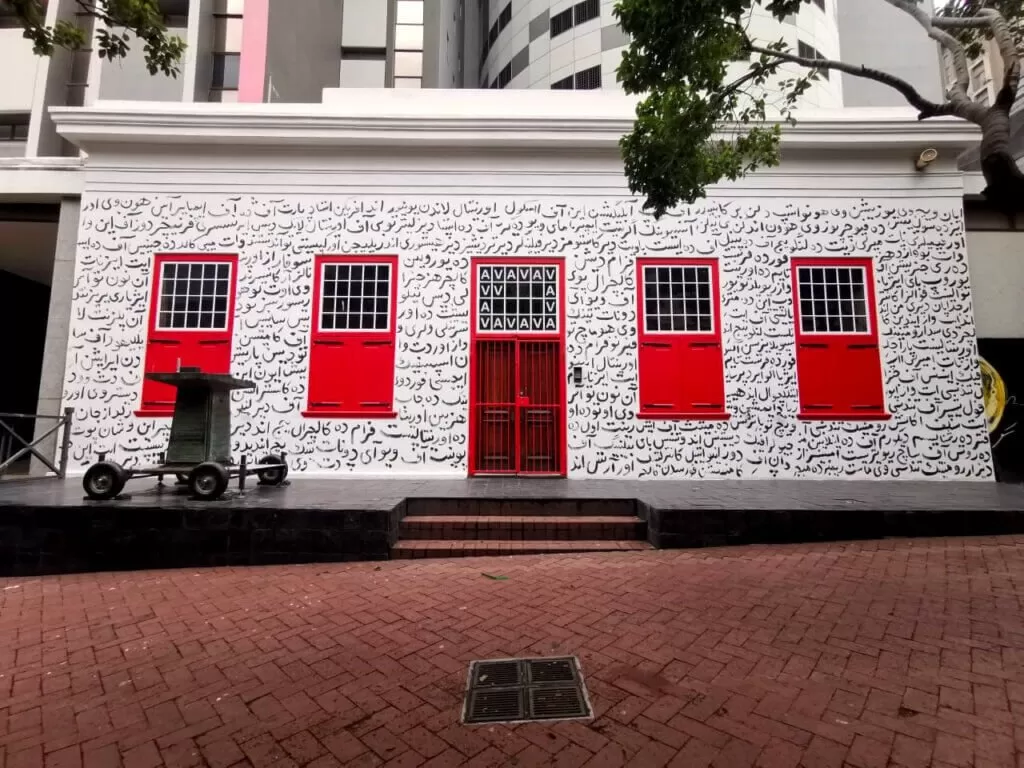
Bineshtarigh did just that in an extension of his graduate project at the Association for Visual Arts (AVA), An Exhaustive Catalogue of Texts Dealing with the Orient. The project included a mural with transcribed passages from Edward Said’s Orientalism. Bineshtarigh himself painting his translation with a brush in one hand and a copy of Said’s text in the other—the original English now morphed into Arabic and Farsi letters. He also placed broken glass fragments throughout AVA Gallery wall space, with an installation sound piece featuring Bineshtarigh’s mother reading the final chapter of Orientalism.
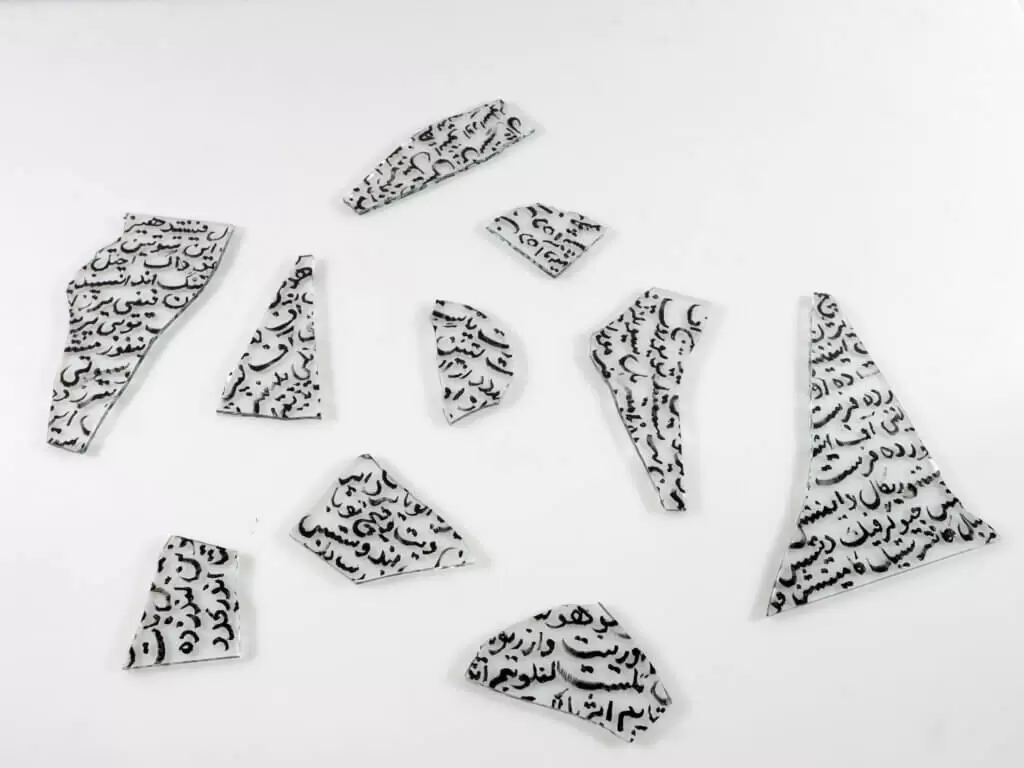

As the artist mentions, the reactions from this public art-making were of a tantalized and sometimes shocked nature, creating, subversively, an even more poignant meta-analysis of Said’s ideas. In the transliteration of a work critical of the Western, orientalist gaze, we are given space to consider how these characters transform into something that seemingly obscures the original English text, but nothing about the text itself is obscured; in fact, new meaning emerges from it.
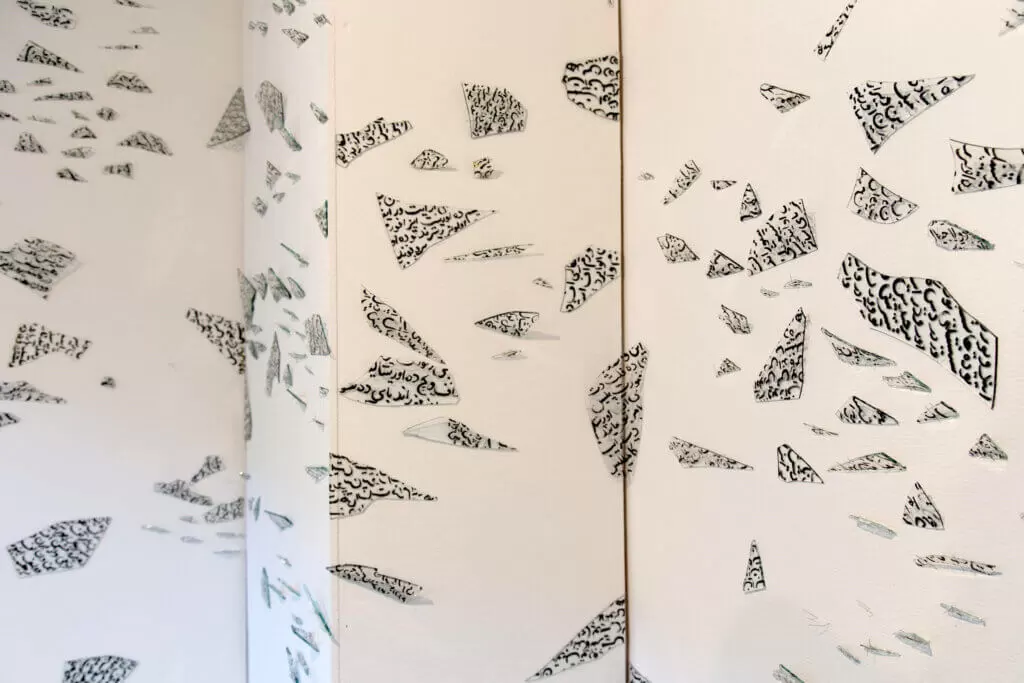
Bineshtarigh himself doesn’t deny the visually interesting value of seeing Arabic and Farsi written out, but like many non-Roman-alphabet languages, they are often considered placeholders for projections of the unknown or the enigmatic, and thus, leave room for misrepresentation. Bineshtarigh illustrates how we conceptualize the dangerous mythmaking of Orientalism without falling into the same cliché traps as other artists dealing with the topic.

In Shiraz, the artist reexamines the manipulation of language and source through marketing and hints at the Western cultural perceptions of Iran pre-and post-Islamic Revolution. Despite Iran’s banning of the production and consumption of alcoholic beverages in 1979, we connote the ancient city of Shiraz with wine; but, it is also a place of literature and poetry, of divine inspiration and beauty. Using laser engravings to depict the city’s name on a wine bottle, Bineshtarigh creates a subliminal bridge between the name as it is captured by a Eurocentric gaze and the place itself. Using laser engravings to depict the city’s name on a wine bottle, Bineshtarigh creates a subliminal bridge between the name as it is captured by a Eurocentric gaze and the place itself.
In the Pilgrim series, the artist merges flashes of obfuscation with those of meditative piety. The individual (evoked by singular brush strokes) is rendered absent among a collective observing prayer. Bineshtarigh’s Pilgrim video was inspired by these bowed inky figures, the video itself comparing the movements of a penguin colony with those of pilgrims attending Hajj in Mecca.
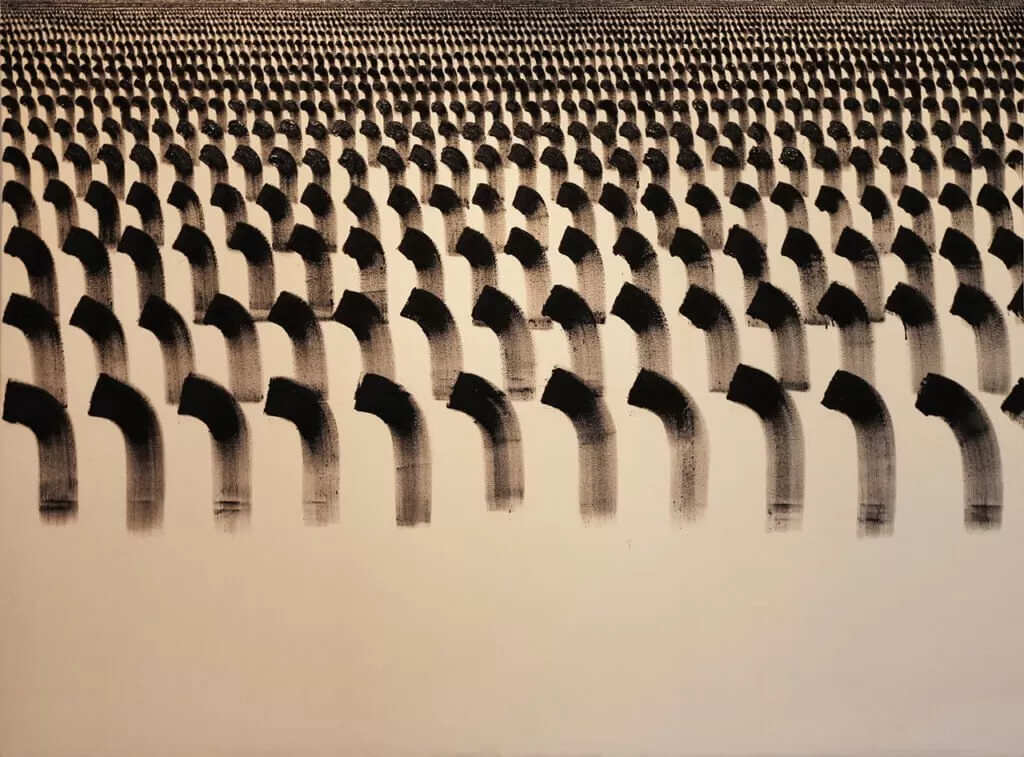

Pilgrims, 2018, 03:03 minutes
In a similar vein, Bineshtarigh initially wanted to create a turbah—or mohr—clay tablet that Shia Muslims use in prayers to symbolize the earth as part of the ‘Shaping Things’ group show at Johannesburg’s SMAC Gallery. Opting instead to create a large tasbih, Bineshtarigh conceptualized his grandmother running beads of her own tasbih through her hand, reciting the Islamic devotional act of zikr from her home in Iran, in a meditative correspondence with her grandson. As the artist Zarina Hashmi passed away in April, while Bineshtarigh was completing the project, he decided to name the work, Tasbih (Homage to Zarina).

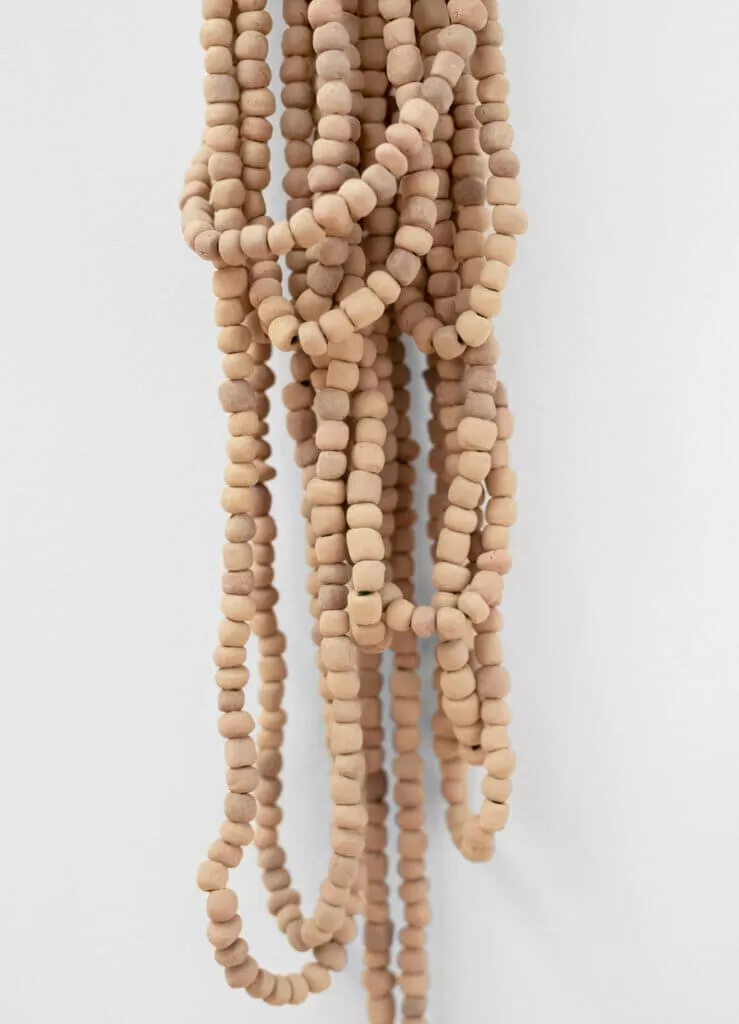
In One (Ode to Kiarostami), Bineshtarigh pays homage to another recently deceased artist: this time, Iranian filmmaker Abbas Kiarostami, the director Bineshtarigh would have trained under in a 2015 workshop that was postponed due to Kiarostami’s filming in China. Kiarostami fell ill and died in 2016. One serves as yet another meta-take that functions as a collaborative eulogy.
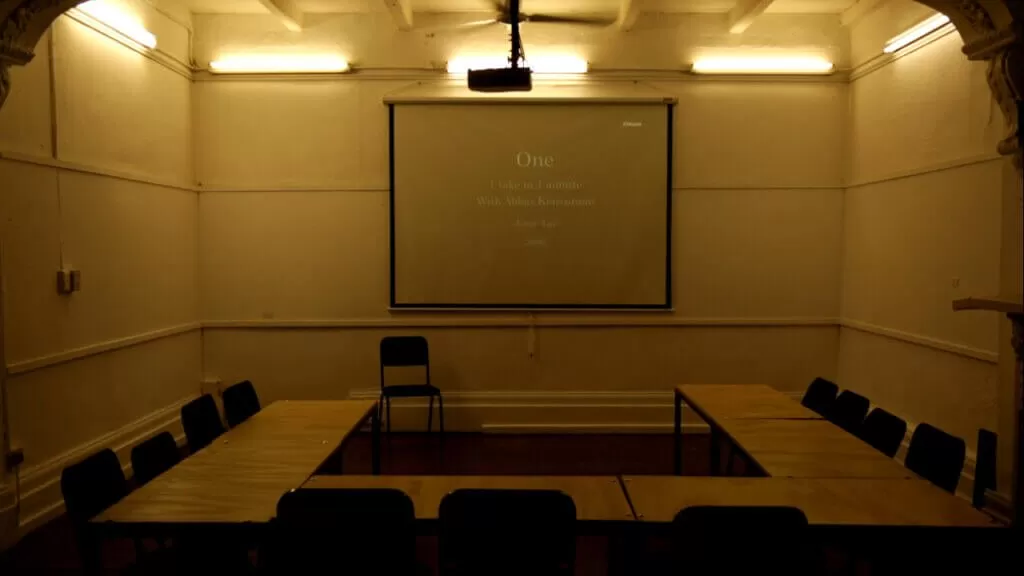
One (Ode to Kiarostami), 2018, 01:16 minutes
The installation is set in a classroom, beginning with a screening of Jorge Tur’s 2006 short film One (1 take in 1 minute with Abbas Kiarostami). Tur captures a silent Kiarostami gazes out of frame, the camera zooming into his turning face, until he eventually looks at us directly with a slight smile. As the film credits roll, the room itself comes to light. The fluorescent light and ceiling fans pulse above the projector screen, revealing the performance within the performance. It calls on Kiarostami’s interest in authenticity and objectivity—or that which is both human and at a distance—in the face of death, of the void.
In this virtual viewing of the director, we feel a remote sense of closure through Bineshtarigh’s eyes. It connects us with his series of One: a set of minimal works draped in delicate chiffon, yet still formidable and imposing in their simplicity, perhaps even a meditation in and of themselves on the infinite certitude of creation and death.
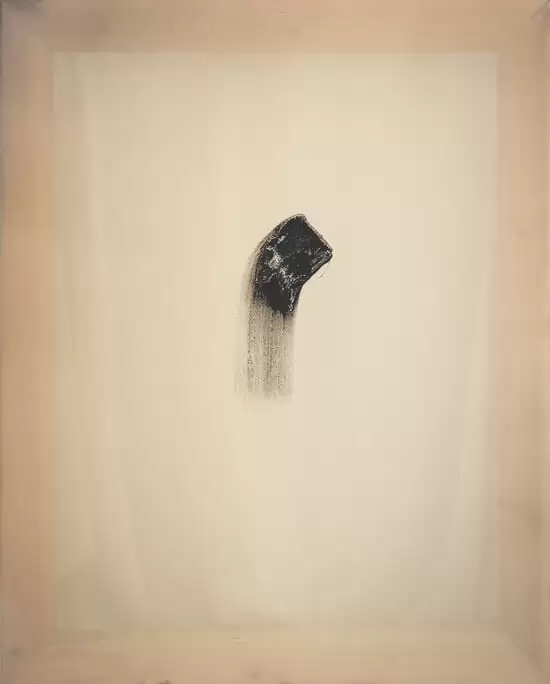
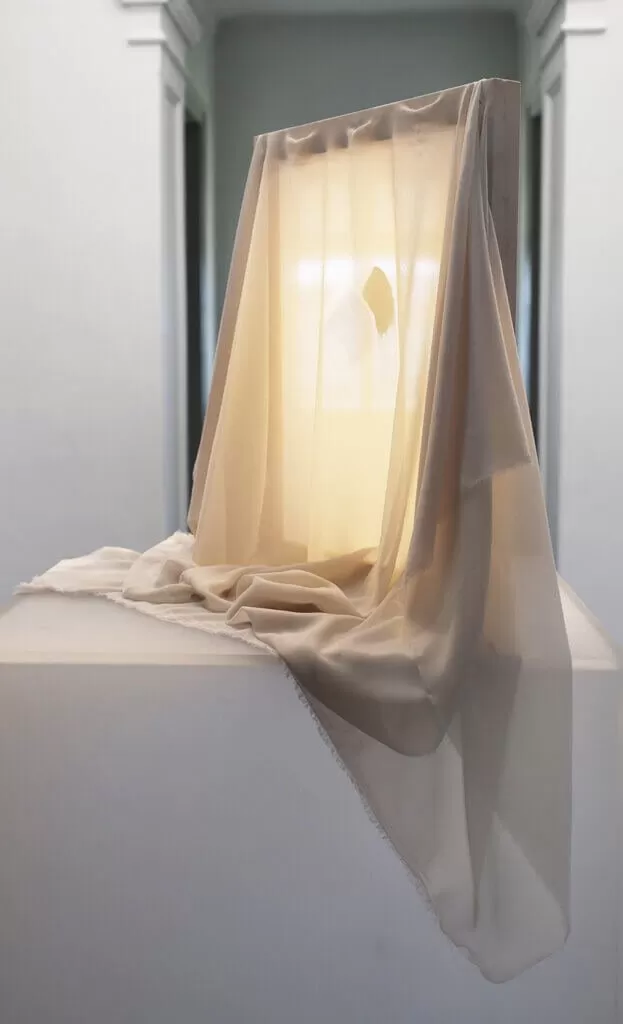
Q: Describe your creative process. Where does it begin for you?
Kamyar Bineshtarigh: I really don’t think there is one beginning, there are endless beginnings and endless ends, I sometimes choose to grab a beginning and sometimes an end. Like with my series of ‘One’s’ I chose to start with ‘One’ and carried on making more One’s and I haven’t yet decided when to make the last ‘One’ so I keep making ‘One’ whenever I feel like ‘One.’

Q: What inspired you to become an artist?
Kamyar Bineshtarigh: I wanted to become a basketball player as a kid but I grew up quite small for basketball; Art was my plan B.
Q: How do you know when a piece is finished?
Kamyar Bineshtarigh: I think the process of making has no absolute ending point for me, I really don’t know when it is finished but I know when I am tired, and I think my energy level is often right, like sometimes I put a single mark on the canvas and I leave it there, and sometimes layers and layers of ink.
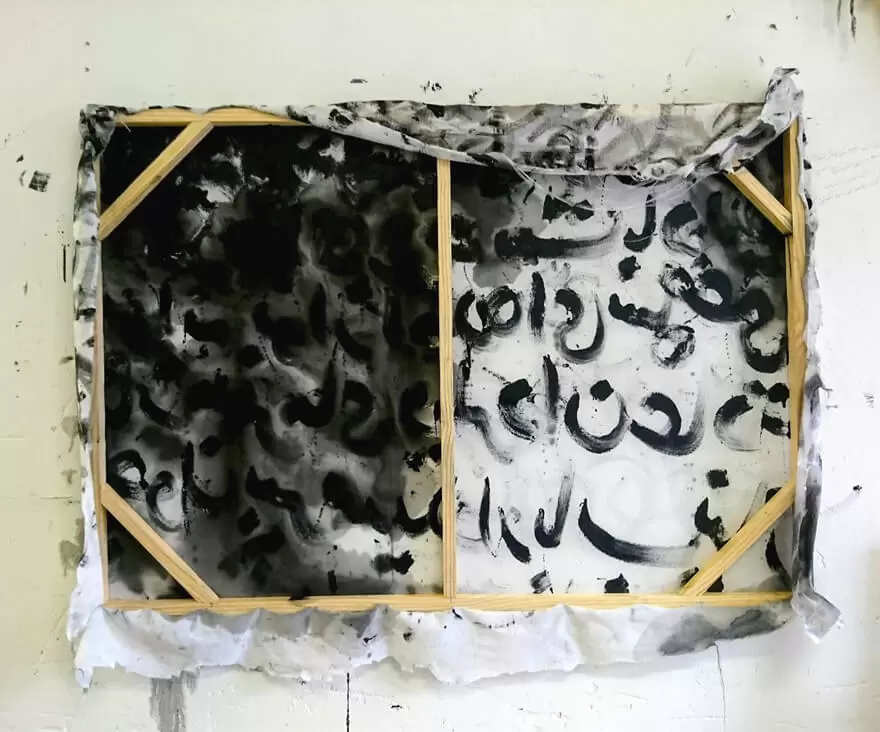
Q: Which themes do you hope to explore in your video series?
Kamyar Bineshtarigh: I can’t say what themes I hope to explore in the future. I am interested in cinema, I discovered the power of moving image and film through Iranian New wave and became fascinated specially with works of filmmaker Abbas Kiarostami, and I’m not saying it because I’m Iranian and I am trying acknowledge my “Iranianess” or subvert my encounter with Eurocentric art world and orientalism, I think Kiarostami is beyond this shallow and constructed understanding of borders and cultures.
At one point I was thinking a lot about displacement and movement and I think it was inevitable since having had experienced immigration at a young age, but I don’t know what I want to explore in the future. What I think is that I will be more influenced by the environment that I live in more than where I come from and I also know that with my videos I want to keep a straddle between cinema, documentary and video art, I don’t want to see them separately, but what video art allows me to do is to be able to make a moving image with limited resources and budget and still be able to present it. I am hoping to even take a step further and make feature films in the future.
Q: Why do you use calligraphy in your work? What is the significance of the other materials you use?
Kamyar Bineshtarigh: A lot of my works are text based but I wouldn’t call it calligraphy, I think professional calligraphers would hate me if I say I am a calligrapher. Calligraphy is really precise, a skill that takes years to learn to finally call yourself a calligrapher, although I am inspired by it; my Father and my uncle are both calligraphers. I have practiced it but I didn’t want it to become my profession and the only aspect of my work, so I decided to move away from it and often just use my hand writing, sometimes I want to use professional calligraphy in my work, and I am privileged to have my father to do it for me, for example [in] my work ‘Shiraz.’ The word Shiraz was calligraphed in Nastaliq by him and then laser engraved on the wine bottle.
To answer your question more broadly [as] to why I use writing, I am interested in language and the aesthetic of text, I am also interested in painting so I think I often use writing the same way a painter would use brush marks but there is a lot to unpack in the aesthetic of Arabic/Farsi characters and how this aesthetic is perceived by a predominantly westernised viewer, I have attempted to unpack this transnational identification. Afrikaans is a good example of these blurred ideas of text, language, culture and religion; first Afrikaans texts were written in the Arabic Alphabet in South Africa.

Q: What are your opinions on translation in the realm of visual art? Do you see it as a gateway to accessibility or a distortion?
Kamyar Bineshtarigh: I don’t think translation can ever give us full accessibility to the original language, we can just hope translators try their best to keep it as close to the original as possible, you don’t want to lose the content, if you now google quotes by Hafez or Rumi in English, you will find thousands of them. They might sound beautiful but they are far from the original Persian, it’s like the translators’ intentions were to shape Hafez and Rumi’s poetry for western consumers, and they have succeeded. Both Rumi and Hafez’s poetry books have been widely sold and shared, but I think it’s very disingenuous.
Touching on this notion, I intend to subvert this very idea of accessibility and replace it with distortion, for example my body of work ‘An Exhaustive Catalogue of Texts Dealing with the Orient’ which included the AVA Mural in the Cape Town city center, I wrote passages from Edward Said’s ‘Orientalism’ original English text using the Arabic/Farsi letters, the result of writing English with Arabic letters was foreign to the eyes of both Arabic or Farsi speaking people as well as locals who are mostly familiar with the Roman characters in their written language but what it revealed was the immediate reaction of public to the aesthetic of the text whether it was exotic to them or they were kind of uncomfortable or offended by it, which was the most two common reaction as I heard.
Q: How did your mural project in Cape Town’s Association for Visual Arts come about?
Kamyar Bineshtarigh: I had my graduation show coming up at Ruth Prowse School of Art in Cape Town, I didn’t want to have my work for the graduation show be limited to the institutional space and somehow I wanted to extend it to the public space, so I thought of the façade of the Association for Visual Arts Gallery, they are a non-profit, membership-based art organization and their façade is often open for artists to propose and do Murals. The gallery is situated in a very central place within [the] city center of Cape Town with a nice walking traffic of both locals and tourists.
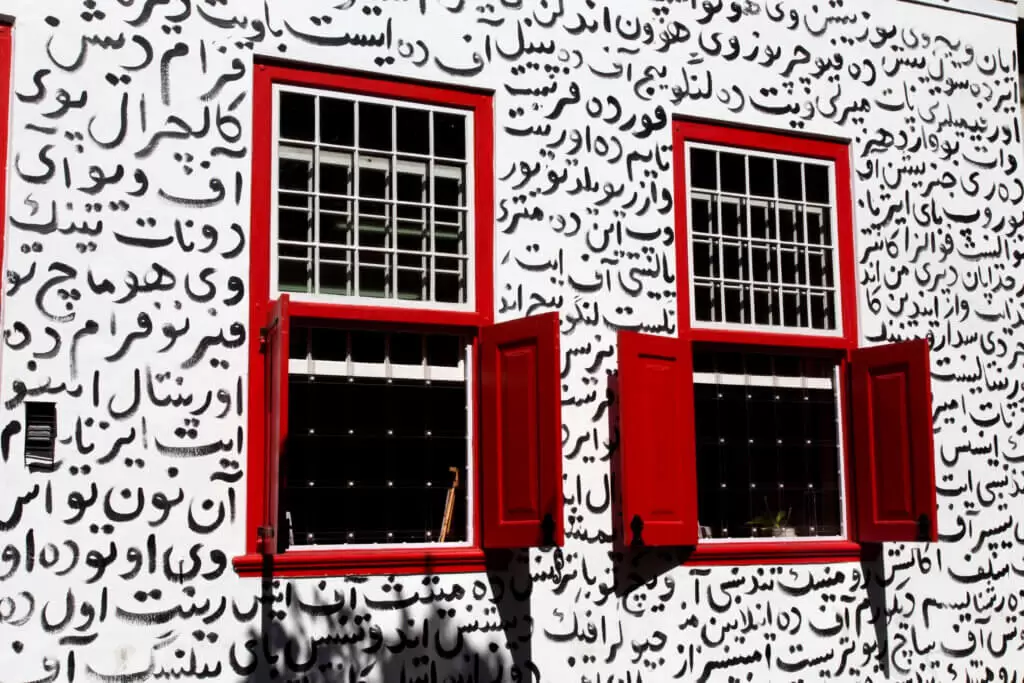
Q: Which of your works resonate the most with you? Do you have a favourite piece or series?
Kamyar Bineshtarigh: I liked the AVA mural; one reason is because it enabled me to take a risk of working in large scale and also allowing my work to interact with [the] public. The temporary aspect of the work was also liberating for me.
Q: What are the most rewarding and challenging aspects of your work as an artist?
Kamyar Bineshtarigh: Answering these questions.
https://www.instagram.com/kamyar_bineshtarigh/
©2020 Kamyar Bineshtarigh


